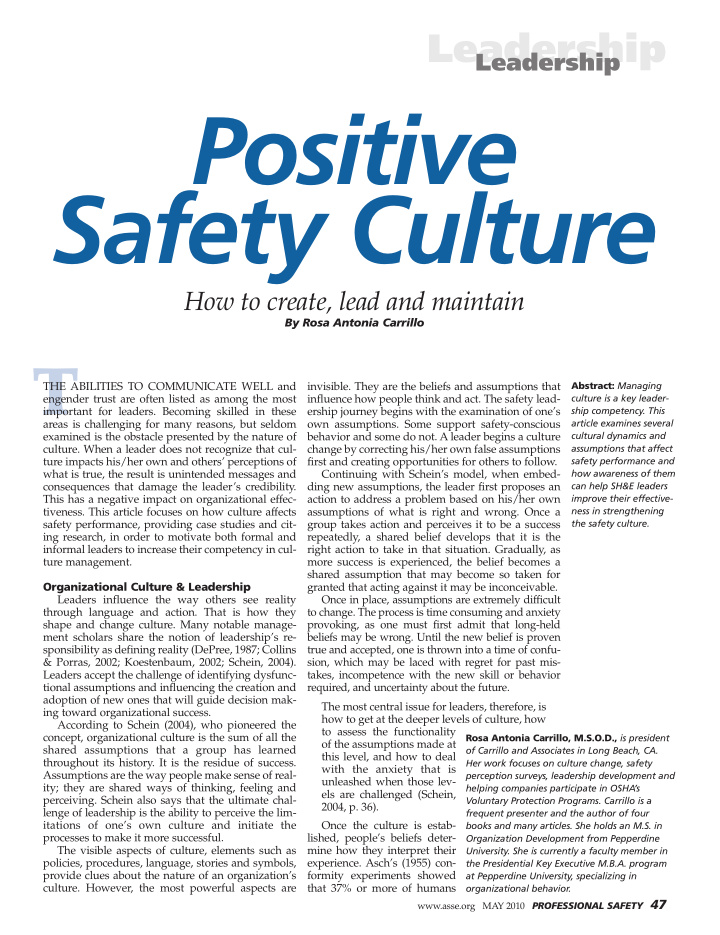



Leadership Leadership Positive Safety Culture How to create, lead and maintain By Rosa Antonia Carrillo T THE ABILITIES TO COMMUNICATE WELL and invisible. They are the beliefs and assumptions that Abstract: Managing engender trust are often listed as among the most influence how people think and act. The safety lead- culture is a key leader- important for leaders. Becoming skilled in these ership journey begins with the examination of one’s ship competency. This areas is challenging for many reasons, but seldom own assumptions. Some support safety-conscious article examines several examined is the obstacle presented by the nature of behavior and some do not. A leader begins a culture cultural dynamics and culture. When a leader does not recognize that cul- change by correcting his/her own false assumptions assumptions that affect ture impacts his/her own and others’ perceptions of first and creating opportunities for others to follow. safety performance and what is true, the result is unintended messages and Continuing with Schein’s model, when embed- how awareness of them consequences that damage the leader’s credibility. ding new assumptions, the leader first proposes an can help SH&E leaders This has a negative impact on organizational effec- action to address a problem based on his/her own improve their effective- tiveness. This article focuses on how culture affects assumptions of what is right and wrong. Once a ness in strengthening safety performance, providing case studies and cit- group takes action and perceives it to be a success the safety culture. ing research, in order to motivate both formal and repeatedly, a shared belief develops that it is the informal leaders to increase their competency in cul- right action to take in that situation. Gradually, as ture management. more success is experienced, the belief becomes a shared assumption that may become so taken for Organizational Culture & Leadership granted that acting against it may be inconceivable. Leaders influence the way others see reality Once in place, assumptions are extremely difficult through language and action. That is how they to change. The process is time consuming and anxiety shape and change culture. Many notable manage- provoking, as one must first admit that long-held ment scholars share the notion of leadership’s re- beliefs may be wrong. Until the new belief is proven sponsibility as defining reality (DePree, 1987; Collins true and accepted, one is thrown into a time of confu- & Porras, 2002; Koestenbaum, 2002; Schein, 2004). sion, which may be laced with regret for past mis- Leaders accept the challenge of identifying dysfunc- takes, incompetence with the new skill or behavior tional assumptions and influencing the creation and required, and uncertainty about the future. adoption of new ones that will guide decision mak- The most central issue for leaders, therefore, is ing toward organizational success. how to get at the deeper levels of culture, how According to Schein (2004), who pioneered the to assess the functionality concept, organizational culture is the sum of all the Rosa Antonia Carrillo, M.S.O.D., is president of the assumptions made at shared assumptions that a group has learned of Carrillo and Associates in Long Beach, CA. this level, and how to deal throughout its history. It is the residue of success. Her work focuses on culture change, safety with the anxiety that is Assumptions are the way people make sense of real- perception surveys, leadership development and unleashed when those lev- ity; they are shared ways of thinking, feeling and helping companies participate in OSHA’s els are challenged (Schein, perceiving. Schein also says that the ultimate chal- Voluntary Protection Programs. Carrillo is a 2004, p. 36). lenge of leadership is the ability to perceive the lim- frequent presenter and the author of four itations of one’s own culture and initiate the Once the culture is estab- books and many articles. She holds an M.S. in processes to make it more successful. lished, people’s beliefs deter- Organization Development from Pepperdine The visible aspects of culture, elements such as mine how they interpret their University. She is currently a faculty member in policies, procedures, language, stories and symbols, experience. Asch’s (1955) con- the Presidential Key Executive M.B.A. program provide clues about the nature of an organization’s formity experiments showed at Pepperdine University, specializing in culture. However, the most powerful aspects are that 37% or more of humans organizational behavior. www.asse.org MAY 2010 PROFESSIONAL SAFETY 47
Recommend
More recommend